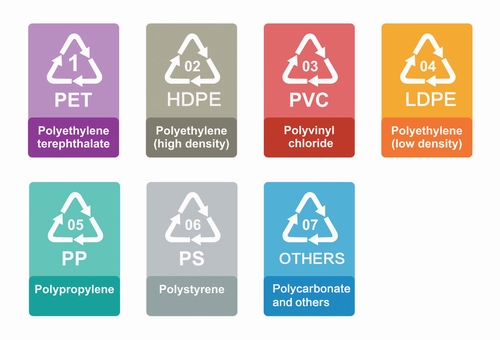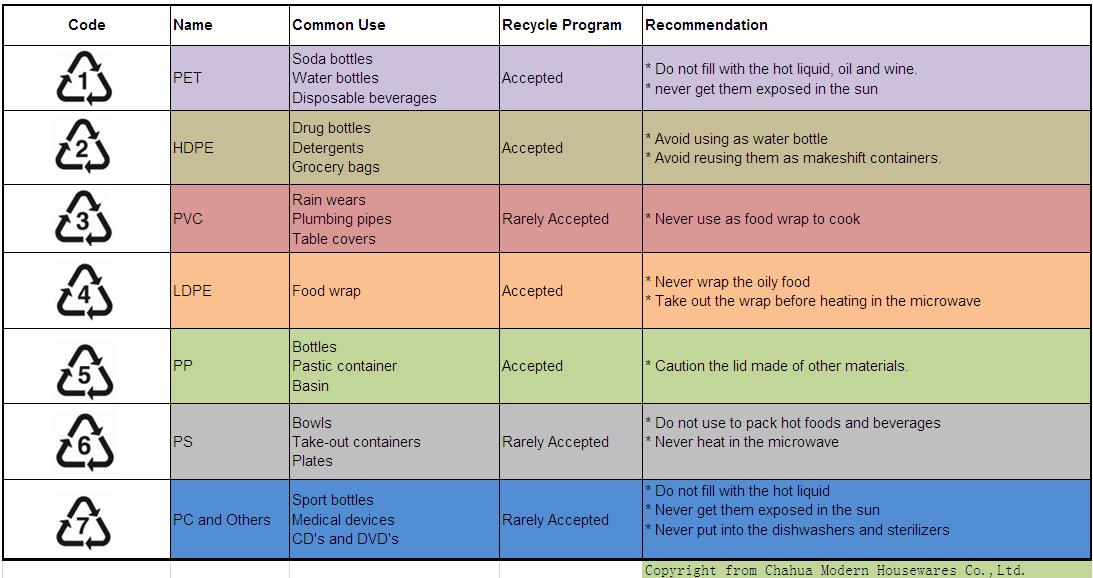How to mitigate the risks from plastics effectively
2019-1-3 11:19:23DATE JAN. 3, 2019
Plastics are not so-called the worst inventions in the world, as they indeed bring so many conveniences in our life. But it cannot be denied that they pose great risks to our health and environment when misusing or overusing.
Therefore using the plastics in the appropriate way can effectively mitigate the risks. Chahua Modern Housewares Co.,Ltd., as a professional plastics manufacturer, is helping you identify the various plastics and giving you some recommendations.
The number within a triangle printed on the bottom of most plastics is what we call ID of them. The triangle is a symbol of recycling, while the number is called the resin identification ranging from 1 to 7 associated with the type of resin used in the plastics.

Plastic #1 Polyethylene Terephthalate (PET)
Polyethylene terephthalate, also known as PETE or PET, is used for soda bottles, water bottles or disposable beverages. It cannot sustain high temperature above 70 degrees Celsius. And it is likely to get deformed in high temperature and leach hazardous substance into your liquids. So just do not fill with the hot liquid, oil and wine, and never have them exposed in the sun. In terms of recycling, it is accepted by recycling programs.
Plastic #2 High Density Polyethylene (HDPE)
HDPE is mostly used for drug bottles, detergents, shampoos, toiletries containers and grocery bags etc. It sustains the high temperature of 110 degrees Celsius. And the grocery bags can be applied in food if they are food-grade. In terms of recycling, it is also accepted by recycling programs.
But it allows bacteria to accumulate easily and moreover it cannot be clean thoroughly, so avoid using as water bottle or reusing them as makeshift containers.
Plastic#3 Polyvinyl Chloride (PVC)
PVC is commonly found in rain wears, plumbing pipes and table covers etc. Although tough in terms of strength and affordable in terms of cost, it is not considered safe in cooking or heating. As it only sustains the temperature of 81 degrees Celsius. Moreover it may leach a kind of softening chemical in high temperature, called phthalate that interferes with hormonal development. So never use as food wrap to cook. In terms of recycling, it is rarely accepted by recycling programs.
Plastic#4 Low Density Polyethylene (LDPE)
LDPE is commonly found in food wrap and plastic wrap. It is relatively considered safe. But it may melt in 110 degree Celsius and pose the risk of leaching the chemicals the human body is unable to eliminate. Never wrap the oily food and also do take out the wrap before heating in the microwave. It is not accepted by recycling programs, but suggested reusing them rather than throwing them away after one use.
Plastic#5 Polypropylene (PP)
Polypropylene is considered a safe plastic for bottles, “microwave-safe” plastic container, basin, chair and other housewares. It can sustain the temperature of 130 degrees Celsius. But sometimes the so-called microwave safe container is not that much safe. As the lid is made of PS, which might leach styrene in hot temperature. In terms of recycling, it is accepted by recycling programs.
Plastic#6 Polystyrene (PS)
Polystyrene is known as Styrofoam. It is often used for instant noodles bowls, take-out containers and plates, meat trays. It is good transparency, and also is stable in the temperature of 70 to 90 degrees Celsius. But it is not suggested using them to pack hot foods and beverages, or heating in the microwave or using in strong acid and strong alkali environment such as chemical Lab. In terms of recycling, it is very difficult to recycle and rarely accepted by recycling programs.
Plastic#7 Others
It describes the products made from other plastic resins not described above. So it is difficult to make sure the type. Chances are that it often contains BPA or BPS. Polycarbonate is one of them. It is used for sport bottles, medical and dental devices, CD's and DVD's due to good transparency.
BPA is an endocrine disrupter, which means it mimics or interferes with your body's hormones and "disrupts" your endocrine system. The higher temperature it gets, the faster it leaches BPA. So never fill the hot liquid in them or get them exposed in the sun. It is suggested that you had better clean in the warm water with soda powder when first use and never put into the dishwashers and sterilizers. In terms of recycling, it is very difficult to recycle and rarely accepted by recycling programs.
We have attached an at-a-glance summary of various plastics as below for easy memory.
Although we cannot avoid using the plastics which do bring the risks to our environment and body, using them rightly, decreasing the use of non-recycling plastics and recycling what is able to recycle for our planet can minimized the risks.
